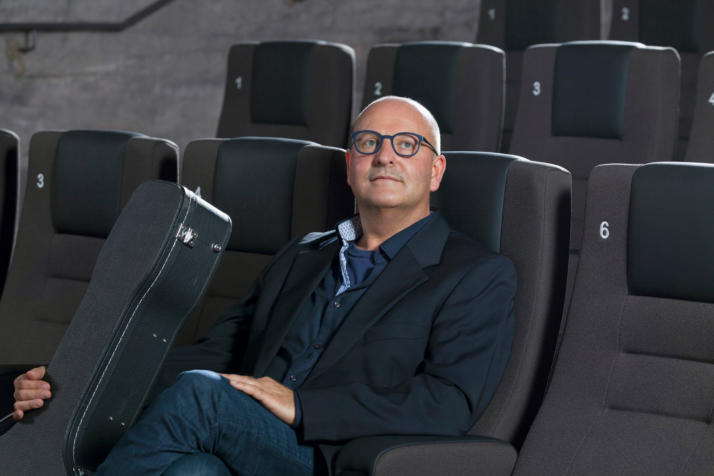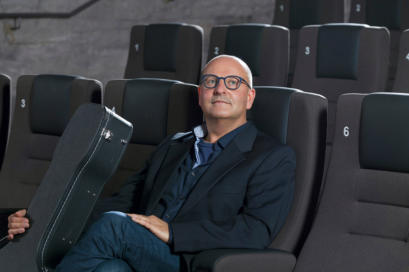
Werner Küspert

Interview-Auszug (English version below):
„Zum Stummfilm bin ich eigentlich per Zufall gekommen: mein erster Kontakt zu diesem Genre kam durch eine
Auftragskomposition für eine Live-Aufführung bei einem Filmfestival. Bis dato kannte ich Stummfilme - wie die meisten
meiner Altersgenossen- nur aus der freitäglichen ZDF-Sendung "Väter der Klamotte": Hans Dieter Hüsch präsentierte mit
launigen Kommentaren Versatzstücke aus diversen Filmen, die Bilder liefen viel zu schnell.
"The Lodger" von Alfred Hitchcock veränderte Ende der achtziger Jahre sozusagen auf einen Schlag meine Vorstellung von der
künstlerischen Qualität und Bedeutung des Stummfilms radikal. "The Lodger" gab es zu dieser Zeit noch längst nicht in einer
digitalisierten Fassung, die 35mm-Film-Kopie musste damals per Spedition vom Londoner Filmarchiv zum Spielort nach
Deutschland transportiert werden (natürlich hochversichert, denn es gab nur noch zwei Kopien!) und damit ich mit dieser
Kopie arbeiten konnte wurde extra ein Kino angemietet um den dort projizierten Film – nicht ganz legal – mit einer VHS-
Kamera für meine Vorbereitung aufzuzeichnen. Man kann sich leicht vorstellen, daß die Bildqualität ausgesprochen
bescheiden war, aber dennoch war meine Faszination groß. Umwerfend, welche Spannung schon damals mit den
vergleichsweise sparsamen technischen Mitteln erzeugt werden konnte – und das ohne Tonspur!
Eine ähnliche Faszination üben auf mich u.a. zwei Klassiker des deutschen Stummfilms aus: "Nosferatu" und "Das Cabinet des
Dr. Caligari"; nach Restaurierung und Digitalisierung kommt deren Kraft und Tiefe erst (wieder) richtig zur Geltung. Mit
meinem Ensemble habe ich beide Filme inzwischen mehr als fünfzig Mal begleiten dürfen, und immer noch bin ich bei jeder
weiteren Aufführung von diesen Filmen wirklich hingerissen. Dankenswerter Weise werden immer mehr Stummfilme durch
die Digitalisierung wieder zugänglich, und so gibt es noch unendlich viele Werke zu entdecken. Mich freut es dabei ganz
besonders, daß in den letzten Jahren immer mehr junge Zuschauer den Weg zu Stummfilm-Aufführungen finden und sich auf
ein besonderes cineastisches Erlebnis einlassen.
Zu meiner Arbeitsweise:
Im Jazz ist es ja ganz besonders wichtig, nicht nur einen eigenen Stil, sondern eine eigene improvisatorische Sprache zu
entwickeln. Ich glaube, dass alle meine Musiker einen eigenen, unverkennbaren Stil gefunden haben, für den bei unseren
Stummfilm-Projekten sehr viel Raum ist. Ich habe nicht nur komplette Stücke geschrieben, sondern auch relativ komplexe
Strukturen geschaffen, innerhalb derer sich die Musiker improvisatorisch bewegen und vor allem in Interaktion zueinander
treten und zudem auf die Bilder reagieren bzw. Bild- und Filmsequenzen musikalisch vorbereiten. Unser Verfahren, dem Film
einen Ton zu geben, ist recht komplex und nebenbei ganz schön anstrengend, auch physisch. Die traditionelle
Stummfilmbegleitung war in der Frühzeit des Kinos für die Musiker relativ unkompliziert: die Pianisten hatten ein freies
Repertoire, da wurde nach Herzenslust drauf los gespielt. Für Ensembles war die Sache schon etwas komplexer, aber immer
noch überschaubar: fertige Partitur, der Dirigent muss zwar auf den Film reagieren – letztlich die gleiche Situation wie bei der
Oper, im Ergebnis mit ebenso geringen Risiken und ebenso vorhersehbar, da ja vorwiegend vorgefertigt. Bei uns läuft das so,
dass wir ein komplettes Film-Manuskript haben (ich habe quasi nachträglich ein Drehbuch geschrieben mit Time-Code), in
dem die Kompositionen und improvisatorischen Strukturen notiert sind. Es müssen also alle Musiker sowohl das Manuskript
verfolgen, den Film natürlich, auf mein Dirigat achten und immer musikalisch im Blick haben, was die Kollegen gerade ad hoc
komponieren (also improvisieren). Nach über 200 verschiedenen „StummFilmLiveJazz“-Projekten (in sehr unterschiedlichen
Besetzungen) glaube ich, ein Verfahren gefunden zu haben, das für die Musiker genügend Freiraum lässt, aber dennoch so
klare Strukturen schafft, dass auch komplexere Kompositionen Platz haben.
Das ist oft ganz schön kompliziert und verlangt uns Musikern so viel an höchster Konzentration ab, wie ich es sonst eigentlich
in keiner anderen Bühnen-Situation erlebe. Der Begriff „zeitgenössischer Jazz“ ist leider nur sehr vage, aber mit engeren
Definitionen kann ich leider nicht dienen. Vorbilder habe ich eigentlich keine; es gibt natürlich sehr, sehr viele Musiker und
Komponisten, die mich beeindrucken und zu denen ich ehrfurchtsvoll aufschaue, aber ich hatte nie das Bestreben, so zu
klingen wie einer der großen Meister...”
Interview excerpt:
"I actually came to silent film by chance: my first contact with this genre was through a commissioned composition for a live
performance at a film festival. Until then, I had only known silent films - like most of my peers - from the Friday ZDF program
“Väter der Klamotte”: Hans Dieter Hüsch presented set pieces from various films with witty commentary, the images ran far
too fast.
At the end of the 1980s, Alfred Hitchcock's “The Lodger” radically changed my idea of the artistic quality and significance of
silent films. At that time, “The Lodger” was far from being available in a digitized version, the 35mm film copy had to be
transported from the London film archive to the venue in Germany by a forwarding agent (highly insured, of course, because
there were only a few copies left!) and so that I could work with this copy, a cinema was rented especially to record the film
projected there - not quite legally - with a VHS camera for my preparation. It's easy to imagine that the picture quality was
extremely modest, but I was still fascinated. It was amazing how much excitement could be generated even then with the
comparatively modest technical means available - and without a soundtrack!
I am similarly fascinated by two classics of German silent film: “Nosferatu” and “The Cabinet of Dr. Caligari”; after restoration
and digitization, their power and depth really come into their own (again). I have been able to accompany both films more
than fifty times with my ensemble, and I am still truly enraptured by these films at every subsequent performance. Thankfully,
more and more silent films are becoming accessible again thanks to digitization, and so there are still countless works to
discover. I am particularly pleased that in recent years more and more young viewers have found their way to silent film
screenings and are enjoying a special cinematic experience.
In jazz it is particularly important not only to develop one's own style, but also one's own improvisational language. I believe
that all my musicians have found their own distinctive style, for which there is a lot of room in our silent projects.
I have not only written complete pieces, but also created relatively complex structures within which the musicians move
improvisationally and, above all, interact with each other and also react to the images or prepare image and film sequences
musically.
Our process of giving the film a sound is quite complex and, besides, quite exhausting, also physically. In the early days of
cinema, traditional silent film accompaniment was relatively uncomplicated for the musicians: the pianists had a free
repertoire, so they played to their heart's content. For ensembles, things were a bit more complex, but still manageable: a
finished score, the conductor has to react to the film - ultimately the same situation as with opera, with just as few risks and
just as predictable a result, since it is mainly prefabricated.
For us, it works like this: we have a complete film manuscript (I wrote a script with time code afterwards, so to speak), in which
the compositions and improvisational structures are notated. So all the musicians have to follow the manuscript, the film of
course, pay attention to my conducting and always have a musical eye on what their colleagues are composing ad hoc (i.e.
improvising).
After more than 200 different "StummFilmLiveJazz" projects (in very different instrumentations), I believe I have found a
procedure that leaves enough freedom for the musicians, but still creates such clear structures that there is room for more
complex compositions.
That is often quite complicated and demands so much of the highest concentration from us musicians that I don't really
experience in any other stage situation.
The term "contemporary jazz" is unfortunately only very vague, but I can't serve with narrower definitions. I don't really have
any role models; there are of course very, very many musicians and composers who impress me and whom I look up to with
reverence, but I have never had the ambition to sound like one of the great masters..."
www.wernerkuespert.de

Werner Küspert

Interview excerpt:
"...In jazz it is particularly important not only to develop
one's own style, but also one's own improvisational
language. I believe that all my musicians have found their
own distinctive style, for which there is a lot of room in
our silent projects.
I have not only written complete pieces, but also created
relatively complex structures within which the musicians
move improvisationally and, above all, interact with each
other and also react to the images or prepare image and
film sequences musically.
Our process of giving the film a sound is quite complex
and, besides, quite exhausting, also physically. In the
early days of cinema, traditional silent film
accompaniment was relatively uncomplicated for the
musicians: the pianists had a free repertoire, so they
played to their heart's content. For ensembles, things
were a bit more complex, but still manageable: a finished
score, the conductor has to react to the film - ultimately
the same situation as with opera, with just as few risks
and just as predictable a result, since it is mainly
prefabricated.
For us, it works like this: we have a complete film
manuscript (I wrote a script with time code afterwards, so
to speak), in which the compositions and improvisational
structures are notated. So all the musicians have to
follow the manuscript, the film of course, pay attention to
my conducting and always have a musical eye on what
their colleagues are composing ad hoc (i.e. improvising).
After more than 200 different "StummFilmLiveJazz"
projects (in very different instrumentations), I believe I
have found a procedure that leaves enough freedom for
the musicians, but still creates such clear structures that
there is room for more complex compositions.
That is often quite complicated and demands so much of
the highest concentration from us musicians that I don't
really experience in any other stage situation.
The term "contemporary jazz" is unfortunately only very
vague, but I can't serve with narrower definitions. I don't
really have any role models; there are of course very, very
many musicians and composers who impress me and
whom I look up to with reverence, but I have never had
the ambition to sound like one of the great masters..."



























